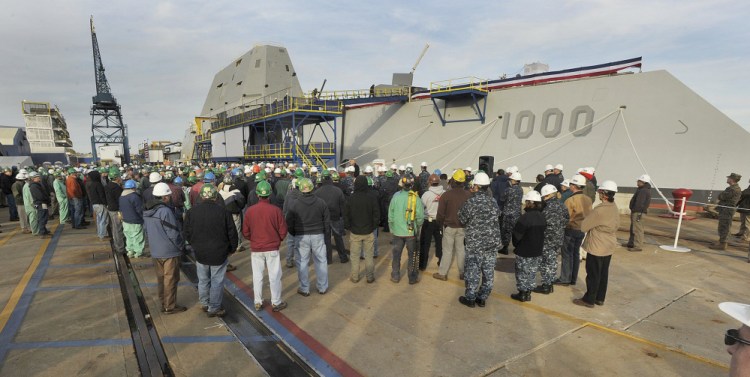For the first time in three years, Mainers living along the southern tip of the Kennebec River could have a chance as early as Monday to see a new Navy destroyer cruise by en route to the Atlantic.
This will be a sight unlike any before, however.
Sea trials for the USS Zumwalt – a 600-foot-long destroyer that is as high-tech on the inside as it is unusual-looking on the outside – are tentatively due to begin Monday, notwithstanding any schedule changes because of weather or other circumstances. It’s a momentous occasion for Bath Iron Works and the Navy, which have invested an estimated $4.3 billion and more than four years building the first version of a next-generation “stealth” destroyer.
“It’s the toughest ship I’ve ever seen,” said Bill Giroux, city manager of Bath, who has been watching Navy ships emerge from “the yard” of BIW for about 50 years. Giroux will be among the sizable crowd expected to gather to watch the Zumwalt float by either from the public park or the Maine Maritime Museum, both located just south of BIW in Bath, or from where the Kennebec meets the Atlantic at Fort Popham and Popham Beach State Park.
Timing could be a challenge, however, because neither the Navy nor BIW will provide a detailed schedule for security reasons. Portland residents can expect the ship to make several port calls in the city during its sea-trial period, although the Navy is not releasing details of those visits, either.
“There is more buzz about this ship than any I can remember just because of the radical design,” Giroux said.
But it won’t be the Zumwalt’s looks put to the test when staff from BIW and the Navy take the roughly 15,000-ton destroyer out into the open ocean for the first time. Instead, engineers will test the computer and power systems aboard the Navy’s first “all-electric” warship.
The first of three Zumwalt-class destroyers to be built at BIW, the ship features a 78-megawatt power plant to supply electricity to every major function of the ship, from its advanced induction propulsion motors and converters to its weapons systems. The multi-purpose ships were designed to operate closer to land – in the so-called “littoral zone” – in support of ground attacks but also in the open seas in battles against other ships, aircraft or submarines, although those weapons systems will not be installed until later.
Observers inside and outside of the Navy will also watch closely to see how the Zumwalt’s unique “tumblehome” hull design – one in which the bow angles inward from the water to the ship’s deck – performs at sea. The hull, angular deckhouse and smooth or enclosed surfaces are designed to help the Zumwalt-class destroyer fool radars to make it look more like a fishing vessel than the largest destroyer ever built for the Navy.
Such tumblehome hulls were largely abandoned in larger ships decades ago because of stability concerns in rough weather, although the Navy has said it is confident in the seaworthiness of the Zumwalt.
Matthew Leonard, spokesman with the Naval Sea Systems Command office in Washington, D.C., said the sea trials will be used to demonstrate the ship’s hull, mechanical and electrical systems during what he described as a “multiday underway period.”
“This underway period will allow for earlier testing, issue identification, and risk mitigation,” Leonard said.
Among those expected to be on board the Zumwalt (the ship doesn’t become the USS Zumwalt until its Navy commissioning) will be the vessel’s first commander, Capt. James Kirk.
“We are absolutely fired up to see Zumwalt get underway,” Kirk said in a statement. “For the crew and all those involved in designing, building, and readying this fantastic ship, this is a huge milestone.”
BIW officials declined to comment on the sea trials, deferring questions to the Navy. Delays in constructing and testing the ship – a common occurrence for “lead” ships of any new class – have pushed back the expected delivery date more than a year. Five other destroyers – two more Zumwalt-class ships and three Arleigh Burke-class destroyers – are also at various stages of construction at BIW.
In the case of the Zumwalt-class ships, the Navy whittled down the number of expected ships from 32 to the current three in response to the rising anticipated costs of the high-tech warships and changing geopolitical environment. Instead, the Navy restarted construction of the Arleigh Burke-class destroyers that have been built at BIW and a Mississippi shipyard for decades. In fact, one of the newest Arleigh Burkes, the Rafael Peralta, currently floats just upriver from the Zumwalt at BIW as crews complete work on the ship’s interior.
This week will be the Zumwalt’s first big test, however.
“The lead ship of a new class is always an interesting and challenging thing for a shipyard to do, and it’s something that has been done many times at BIW,” said Nathan Lipfert, senior curator at the Maine Maritime Museum, located in the community that bills itself as the City of Ships. “It’s always a matter of pride when a shipyard gets chosen to do a lead ship.”
Send questions/comments to the editors.




Comments are no longer available on this story